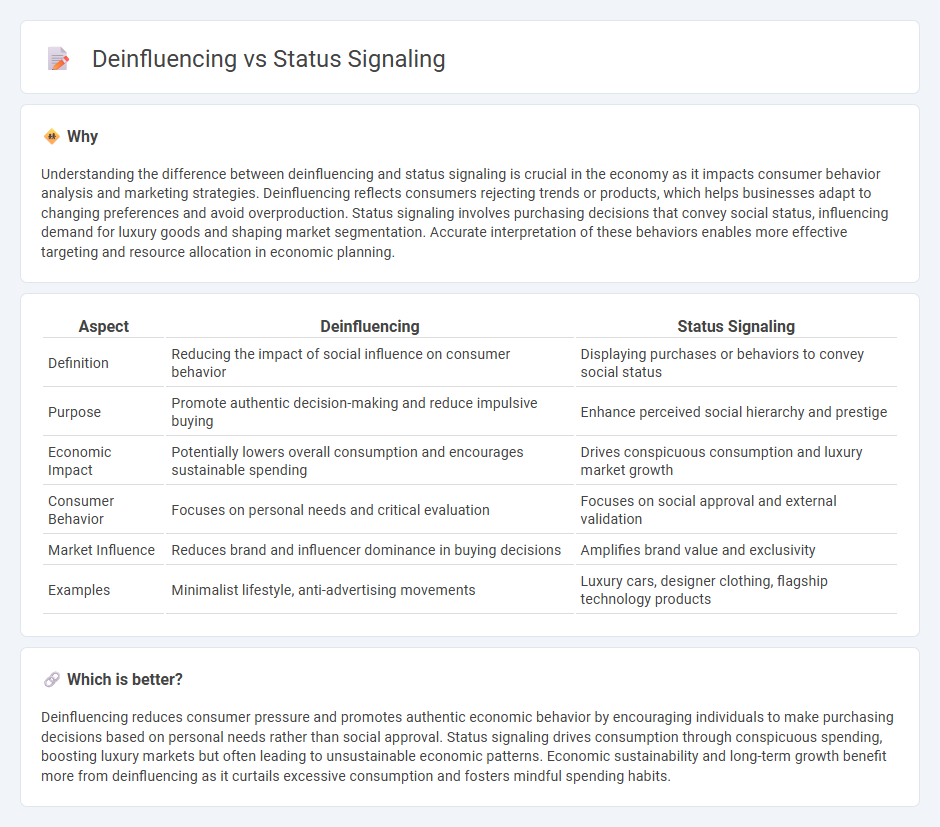
Deinfluencing shifts consumer behavior by promoting authenticity and mindful spending, contrasting sharply with status signaling, which drives purchases to display wealth and social status. This economic trend affects market dynamics as brands adjust to changing demands focused less on image and more on value. Discover how these opposing forces redefine consumption patterns and shape future economic growth.
Why it is important
Understanding the difference between deinfluencing and status signaling is crucial in the economy as it impacts consumer behavior analysis and marketing strategies. Deinfluencing reflects consumers rejecting trends or products, which helps businesses adapt to changing preferences and avoid overproduction. Status signaling involves purchasing decisions that convey social status, influencing demand for luxury goods and shaping market segmentation. Accurate interpretation of these behaviors enables more effective targeting and resource allocation in economic planning.
Comparison Table
| Aspect | Deinfluencing | Status Signaling |
|---|---|---|
| Definition | Reducing the impact of social influence on consumer behavior | Displaying purchases or behaviors to convey social status |
| Purpose | Promote authentic decision-making and reduce impulsive buying | Enhance perceived social hierarchy and prestige |
| Economic Impact | Potentially lowers overall consumption and encourages sustainable spending | Drives conspicuous consumption and luxury market growth |
| Consumer Behavior | Focuses on personal needs and critical evaluation | Focuses on social approval and external validation |
| Market Influence | Reduces brand and influencer dominance in buying decisions | Amplifies brand value and exclusivity |
| Examples | Minimalist lifestyle, anti-advertising movements | Luxury cars, designer clothing, flagship technology products |
Which is better?
Deinfluencing reduces consumer pressure and promotes authentic economic behavior by encouraging individuals to make purchasing decisions based on personal needs rather than social approval. Status signaling drives consumption through conspicuous spending, boosting luxury markets but often leading to unsustainable economic patterns. Economic sustainability and long-term growth benefit more from deinfluencing as it curtails excessive consumption and fosters mindful spending habits.
Connection
Deinfluencing reduces consumer reliance on social media endorsements, shifting focus from latest trends to personal preferences, which alters traditional status signaling dynamics. Status signaling often relies on visible consumption patterns that convey wealth or social status; deinfluencing challenges this by promoting authenticity over conspicuous consumption. This shift impacts economic behavior by encouraging more deliberate purchasing decisions, potentially affecting market demand for luxury and status-driven goods.
Key Terms
Conspicuous Consumption
Conspicuous consumption refers to purchasing goods to display wealth and social status, often driving aggressive status signaling through luxury brands and exclusive products. Deinfluencing challenges this behavior by promoting minimalism and authentic identity over material displays, reducing the social pressure to acquire expensive items for validation. Explore how shifting consumer values impact luxury markets and social dynamics in today's economy.
Social Capital
Status signaling involves individuals showcasing wealth, achievements, or lifestyle to elevate social capital and gain influence within networks. Deinfluencing counters this by promoting authenticity and rejecting excessive consumption, fostering genuine connections rather than superficial status. Explore how these contrasting approaches shape social capital dynamics in modern society.
Consumer Behavior
Status signaling involves consumers purchasing and displaying products to communicate social status and identity, leveraging brand prestige and exclusivity to influence buying decisions. Deinfluencing counters this by encouraging conscious consumption, promoting minimalism and authenticity over conspicuous consumption, thereby shifting consumer behavior towards sustainability and self-awareness. Explore how these opposing trends reshape market dynamics and individual purchasing patterns.
Source and External Links
Status Signaling - Term - Lifestyle - Sustainability Directory - Status signaling is the act of communicating social status, values, or aspirations through visible choices and behaviors, such as the clothes one wears or products one chooses, serving both as a message to others and a reinforcement of self-identity within a social hierarchy.
How Status Signaling Evolved - Erik Torenberg - Substack - Status signaling has evolved to include subtle or counter signals where high-status individuals avoid obvious displays to evade envy, while others continuously jockey for status in a complex social hierarchy, often through cultural knowledge or lifestyle choices.
Status Signals - The Personal MBA - Status signals are tangible indicators that reveal intangible qualities which increase a person's social status or group affiliation, essentially serving as markers recognized within social contexts to convey prestige or belonging.
 dowidth.com
dowidth.com